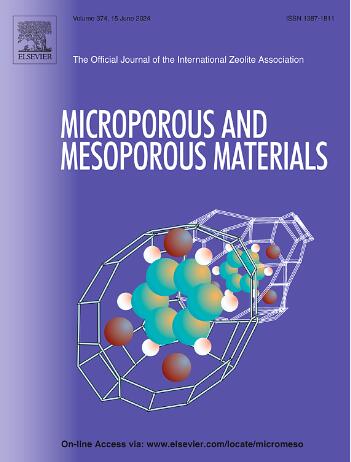Exploring zeolite potential for hydrofluorocarbon capture and recycling: Insights from molecular simulations
IF 4.8
3区 材料科学
Q1 CHEMISTRY, APPLIED
引用次数: 0
Abstract
The need for efficient separation of hydrofluorocarbons for recycling and environmental protection is critical due to their substantial impact on global warming. However, conventional methods such as cryogenic distillation face significant limitations due to the azeotropic behavior of many of these hydrofluorocarbons. This study evaluates the adsorption behavior of various hydrofluorocarbons in zeolite structures, specifically Linde Type A (3A, 4A, and 5A) and Faujasite Type X (13X), using molecular dynamics and grand canonical Monte Carlo simulations. The simulations were validated against experimental data, confirming the reliability of the computational models. Adsorption isotherms were fitted using the Langmuir-Freundlich model to describe the adsorption behavior across different pressures. Focusing on fluoromethane derivatives, the study highlighted key interactions and adsorption capacities in various zeolites. The isotherms of various hydrofluorocarbons in zeolite 13X were explored, revealing differential adsorption based on molecular structure. The potential for using zeolite 13X and 5A to separate refrigerant mixtures was also studied, showing distinct selectivity patterns. Additionally, the temperature dependence of adsorption isotherms and isosteric heat was studied to gain insights into the thermodynamics of the adsorption processes. Key results indicate that zeolite 13X demonstrates strong cation-fluorine interactions, particularly effective for the adsorption of large hydrofluorocarbon molecules, which preferentially occupy 12-membered ring windows. In contrast, zeolite 5A exhibited predominant hydrogen bonding interactions at low pressures, with hydrofluorocarbon molecules occupying the smaller 8-membered ring windows. These findings underscore the selective adsorption capabilities of these zeolites, highlighting their potential application in hydrofluorocarbon separation and recycling processes.

求助全文
约1分钟内获得全文
求助全文
来源期刊

Microporous and Mesoporous Materials
化学-材料科学:综合
CiteScore
10.70
自引率
5.80%
发文量
649
审稿时长
26 days
期刊介绍:
Microporous and Mesoporous Materials covers novel and significant aspects of porous solids classified as either microporous (pore size up to 2 nm) or mesoporous (pore size 2 to 50 nm). The porosity should have a specific impact on the material properties or application. Typical examples are zeolites and zeolite-like materials, pillared materials, clathrasils and clathrates, carbon molecular sieves, ordered mesoporous materials, organic/inorganic porous hybrid materials, or porous metal oxides. Both natural and synthetic porous materials are within the scope of the journal.
Topics which are particularly of interest include:
All aspects of natural microporous and mesoporous solids
The synthesis of crystalline or amorphous porous materials
The physico-chemical characterization of microporous and mesoporous solids, especially spectroscopic and microscopic
The modification of microporous and mesoporous solids, for example by ion exchange or solid-state reactions
All topics related to diffusion of mobile species in the pores of microporous and mesoporous materials
Adsorption (and other separation techniques) using microporous or mesoporous adsorbents
Catalysis by microporous and mesoporous materials
Host/guest interactions
Theoretical chemistry and modelling of host/guest interactions
All topics related to the application of microporous and mesoporous materials in industrial catalysis, separation technology, environmental protection, electrochemistry, membranes, sensors, optical devices, etc.
 求助内容:
求助内容: 应助结果提醒方式:
应助结果提醒方式:


